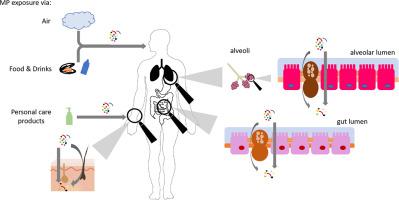NanoImpact ( IF 4.9 ) Pub Date : 2022-11-24 , DOI: 10.1016/j.impact.2022.100441 Anja F R M Ramsperger 1 , Enrico Bergamaschi 2 , Marco Panizzolo 2 , Ivana Fenoglio 3 , Francesco Barbero 3 , Ruud Peters 4 , Anna Undas 4 , Sebastian Purker 5 , Bernd Giese 5 , Carina R Lalyer 5 , Alba Tamargo 6 , M Victoria Moreno-Arribas 6 , Hans-Peter Grossart 7 , Dana Kühnel 8 , Jana Dietrich 9 , Friedrich Paulsen 9 , Anani K Afanou 10 , Shan Zienolddiny-Narui 10 , Stine Eriksen Hammer 10 , Torunn Kringlen Ervik 10 , Pål Graff 10 , Bendik C Brinchmann 11 , Karl-Christian Nordby 10 , Håkan Wallin 10 , Matteo Nassi 12 , Federico Benetti 12 , Michela Zanella 12 , Julian Brehm 13 , Holger Kress 14 , Martin G J Löder 13 , Christian Laforsch 13

|
Contamination of the environment with nano-and microplastic particles (NMPs) and its putative adverse effects on organisms, ecosystems, and human health is gaining increasing scientific and public attention. Various studies show that NMPs occur abundantly within the environment, leading to a high likelihood of human exposure to NMPs. Here, different exposure scenarios can occur. The most notable exposure routes of NMPs into the human body are via the airways and gastrointestinal tract (GIT) through inhalation or ingestion, but also via the skin due to the use of personal care products (PCPs) containing NMPs. Once NMPs have entered the human body, it is possible that they are translocated from the exposed organ to other body compartments. In our review article, we combine the current knowledge on the (1) exposure routes of NMPs to humans with the basic understanding of the potential (2) translocation mechanisms into human tissues and, consequently, their (3) fate within the human body. Regarding the (1) exposure routes, we reviewed the current knowledge on the occurrence of NMPs in food, beverages, personal care products and the air (focusing on indoors and workplaces) and found that the studies suggest an abundant presence of MPs within the exposure scenarios. The overall abundance of MPs in exposure matrices relevant to humans highlights the importance of understanding whether NMPs have the potential for tissue translocation. Therefore, we describe the current knowledge on the potential (2) translocation pathways of NMPs from the skin, GIT and respiratory systems to other body compartments. Here, particular attention was paid to how likely NMPs can translocate from the primary exposed organs to secondary organs due to naturally occurring defence mechanisms against tissue translocation. Based on the current understanding, we conclude that a dermal translocation of NMPs is rather unlikely. In contrast, small MPs and NPs can generally translocate from the GIT and respiratory system to other tissues. Thus, we reviewed the existing literature on the (3) fate of NMPs within the human body. Based on the current knowledge of the contamination of human exposure routes and the potential translocation mechanisms, we critically discuss the size of the detected particles reported in the fate studies. In some cases, the particles detected in human tissue samples exceed the size of a particle to overcome biological barriers allowing particle translocation into tissues. Therefore, we emphasize the importance of critically reading and discussing the presented results of NMP in human tissue samples.
中文翻译:

纳米塑料和微塑料:全面回顾它们在人类中的暴露途径、易位和命运
纳米和微塑料颗粒 (NMP) 对环境的污染及其对生物体、生态系统和人类健康的假定不利影响越来越受到科学界和公众的关注。多项研究表明,NMP 大量存在于环境中,导致人类极有可能接触到 NMP。在这里,可能会出现不同的曝光场景。NMPs 进入人体最显着的暴露途径是通过呼吸道和胃肠道 (GIT) 吸入或摄入,但也由于使用含有 NMPs 的个人护理产品 (PCP) 而通过皮肤。一旦 NMP 进入人体,它们就有可能从暴露的器官转移到其他身体部位。在我们的评论文章中,我们将当前关于 (1) NMP 对人类的暴露途径的知识与对潜在 (2) 易位机制进入人体组织的基本理解相结合,从而了解它们在人体内的 (3) 归宿。关于 (1) 暴露途径,我们回顾了目前关于食品、饮料、个人护理产品和空气(重点是室内和工作场所)中 NMPs 存在的知识,发现研究表明暴露中存在大量 MPs场景。与人类相关的暴露矩阵中 MP 的总体丰度突出了了解 NMP 是否具有组织易位潜力的重要性。因此,我们描述了当前关于 NMP 从皮肤、GIT 和呼吸系统到其他身体隔室的潜在 (2) 易位途径的知识。这里,由于自然发生的针对组织易位的防御机制,特别关注 NMPs 从主要暴露器官转移到次级器官的可能性。根据目前的理解,我们得出结论,NMP 发生真皮移位的可能性很小。相反,小型 MP 和 NP 通常可以从 GIT 和呼吸系统转移到其他组织。因此,我们回顾了关于 (3) NMPs 在人体内命运的现有文献。基于目前对人类暴露途径污染和潜在易位机制的了解,我们批判性地讨论了命运研究中报告的检测到的颗粒的大小。在某些情况下,在人体组织样本中检测到的颗粒超过了颗粒的大小,以克服允许颗粒易位进入组织的生物屏障。因此,我们强调批判性阅读和讨论 NMP 在人体组织样本中的呈现结果的重要性。



























 京公网安备 11010802027423号
京公网安备 11010802027423号